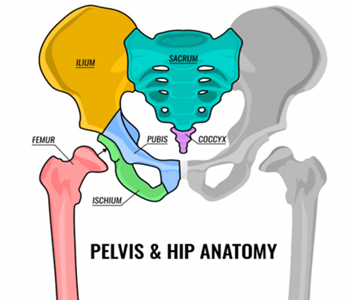Best Pelvic Fracture Doctors in Gurgaon
What Exactly Is a Pelvic Fracture?
A pelvic fracture occurs when any of the huge butterfly-shaped group of bones near the base of the spine-the ilium, ischium, and pubis-is injured.
Pelvic fractures can affect the ilium, ischium, pubis, as well as the acetabulum.
Fracture of the ilium. The ilia are spherical, flat bones that make up the two largest pelvic bones. They are placed on either side of the body above the legs and resemble a butterfly's wing. This fracture is frequently caused by falls or other mishaps.
Fractures of the ischium and pubis. Each ilium is surrounded by a ring-shaped structure made up of the ischium and pubis bones. These fractures are frequently caused by falls or other mishaps.

Fracture of the acetabulum. The acetabulum is a socket on either side of the pelvis. This fracture is frequently caused by a car accident or a fall from a great height, along with damage to other bones and soft structures in and around the hip and pelvis.
Pelvic Stress Fracture. This form of fracture is typically caused by repetitive, high-impact activity that stresses the pelvis, such as long-distance running or dance. This sort of fracture is also common in osteoporosis patients.
What Are the Signs and Symptoms of a Pelvic Fracture?
The symptoms of a fractured pelvis vary depending on the severity of the injury, but they often include severe pain in the hip or groin, swelling and bruising on the skin, and limited ability to bear weight on the affected hip.
Who Is Predisposed to Pelvic Fractures?
- Adults over the age of 60 as a result of falls;
- Postmenopausal women with osteoporosis are particularly vulnerable.
- Repeated high-impact exercise in athletes may result in a stress fracture, which is a microscopic crack in the pelvic bone.
What Are the Causes of Pelvic Fractures?
- traumatic injuries from a car accident or a fall from a big height;
- shattered bones are a real possibility if you have osteoporosis.
Pelvic Fractures: How Are They Diagnosed?
Your doctor may ask you about the location and degree of your pain, how the injury occurred, your medical history, and any other medical disorders you may have, such as osteoporosis, when evaluating your injury.
- Imaging studies, such as an X-ray, can assist detect the site of a fracture, the number of bones involved, and whether an injury has harmed surrounding soft tissues such as tendons, ligaments, blood vessels, or nerves.
- CT scans may also investigate a fracture pattern or determine the extent of hip joint injury. It may also reveal the existence of tiny bone fragments that must be surgically removed.
- To look for minor hairline fractures, an MRI or bone scan may be ordered.
What Is the Treatment for Pelvic Fractures?
Your doctor may offer nonsurgical or surgical therapy for pelvic fractures depending on the severity of your injury.
Nonsurgical Procedures
When hip or pelvic fractures are nondisplaced, meaning the bone fragments remain in place, these are frequently suggested. In this context, your doctor may suggest any of the following:
- Modification of Activity. To allow the bone to heal, you will need to limit your activity so that you do not place any weight on the damaged hip for at least 6 weeks. You may use crutches, a walker, a cane, or a wheelchair to get around during this time.
- Electronic and ultrasonic bone stimulation is available. These types of bone stimulation serve to speed up bone healing by stimulating your body to release proteins that begin to repair cells at the location of the injury with either a low electric current or low-intensity pulsed sound waves.
- Physical Therapy. After the injured pelvic bone heals, a physical therapist will work with you to teach you exercises to help maintain range of motion and strength in the joints and muscles surrounding the injury.
- Medication for pain. discomfort relievers may be provided for the first 1 - 2 weeks following your accident, after which you will use over-the-counter drugs to help relieve discomfort.
Surgical Procedures
- Unless the fracture is serious, you won't require surgery to repair it.
- Surgery is frequently used to minimize fractures, stabilize bones, and heal soft tissue structures.
How Long Does It Take to Recover From Hip and Pelvic Fractures?
In most cases, recovering from a shattered pelvis takes many months. :

